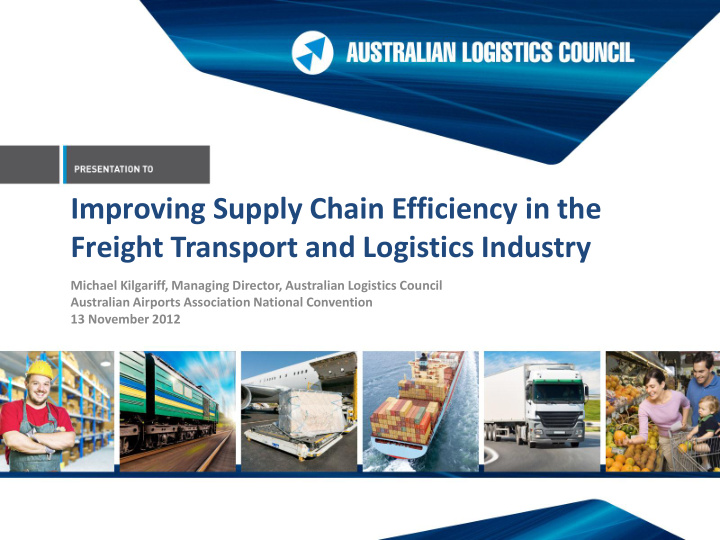



Improving Supply Chain Efficiency in the Freight Transport and Logistics Industry Michael Kilgariff, Managing Director, Australian Logistics Council Australian Airports Association National Convention 13 November 2012
ASIAN WHITE PAPER • Australia’s large and rising freight task includes significant growth in the air freight sector. • Asian White Paper stated air freight volumes are expected to double by 2025. • Appropriate infrastructure – including airports - is essential to enabling cross-border trade and travel.
A RISING NATIONAL FREIGHT TASK • International freight tonnage went from 700,000 tonnes (2008-09) to more than 820,000 tonnes (201-11) – an increase of 14 per cent . • More than 650,000 tonnes of cargo pass through Sydney Airport each year • By 2035, the airport will be dealing with more than 1.5 million tonnes of cargo each year.
FREIGHT MUST BE CONSIDERED ‘CORE BUSINESS’ • Freight is already considered core business for airlines, and so it should be for airports. • Air freight facilities are the lynchpin between passenger and freight aircraft and road efficiency. • Get the air freight facility and supporting infrastructure right. • All airports are critical links in the supply chain.
ISSUES OF CONCERN TO THE INDUSTRY • Transparency surrounding the imposition of fees and charges on freight operators at some airports. • Businesses that support and provide vital aeronautical services at airports should be acknowledged as the primary users of the facilities. • Objections to the “take it or leave it” approach by some airport operators. • The ‘disconnect’ between airport planning and the needs of domestic and international freight services.
ISSUES OF CONCERN TO THE INDUSTRY • Airports do not necessarily understand freight operators’ needs and vice versa. There needs to be: – Greater appreciation of the number and frequency of vehicles needing airport access to support the domestic freight effort. – Greater appreciation from airports about the key differences between domestic and international air freight environments. – Less ‘shuffling’ of freight providers to extreme ends of the airports. • Northern Lands example.
FIXING THE DISCONNECT • The path to achieving a more sensible outcome is through better long term planning. • Amend the Airports Act 1996 so that airport master plans provide specific details on plans to move freight long term. • Consultation with industry must take place before the plan is made.
THE QUESTION OF CONGESTION • Congestion affects all aviation stakeholders. • Bottlenecks around all airports require greater government focus. • Improvement is evident, for example Melbourne’s planned East West Link and Sydney’s proposed WestConnex project. • However, more can be done…
A SECOND SYDNEY AIRPORT • There is a clear need for a second airport in Sydney. • The Joint Study on Aviation Capacity found: ‘ Demand for freight services cannot be met at Sydney Airport if additional capacity could not be added by 2035.’ • ALC believes a second Sydney Airport would: 1) Reduce congestion at, and the corridors linking to, Sydney Airport; and 2) Add price competition to the Sydney Air Freight market. • Tralee decision reinforces need to move on a second airport.
IN CONCLUSION • Improving productivity and efficiency must be at the heart of decision making when it comes to freight. • Freight must be considered core business for airports. • It needs to be front of mind when it comes to government policy making. • And part of long term planning of our cities, our transport links and our broader logistics infrastructure. THANK YOU & QUESTIONS
Recommend
More recommend